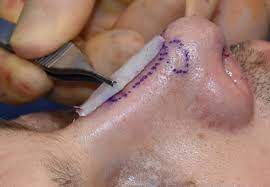 A “saddle nose” in the context of rhinoplasty refers to a deformity where the bridge of the nose has a concave or flattened appearance, resembling the shape of a saddle. This deformity occurs when there is a loss of structural support in the nasal bridge, leading to a collapse of the midportion of the nose.
A “saddle nose” in the context of rhinoplasty refers to a deformity where the bridge of the nose has a concave or flattened appearance, resembling the shape of a saddle. This deformity occurs when there is a loss of structural support in the nasal bridge, leading to a collapse of the midportion of the nose.
There are various potential causes for a saddle nose deformity, including:
- Over-resection during rhinoplasty or septoplasty: If too much cartilage and bone are removed during a rhinoplasty or septoplasty procedure, it can result in a weakened nasal structure, leading to a saddle nose appearance.
- Trauma: Nasal trauma, such as a significant injury or multiple injuries over time, can damage the nasal structure and contribute to the development of a saddle nose.
- Congenital factors: Some individuals may be born with a predisposition to a weak nasal structure that can lead to a saddle nose deformity.
- Inflammatory conditions: Diseases that affect the cartilage and tissues of the nose, such as certain types of autoimmune diseases, may contribute to the development of a saddle nose.
How Do You Fix a Saddle Nose Deformity
Correction of a saddle nose typically involves reconstructive rhinoplasty, where the surgeon aims to restore the nasal structure  and support. This may involve using cartilage grafts, often taken from the patient’s own body (such as the septum, ear, or even rib), to rebuild the nasal bridge and create a more aesthetically pleasing and functional nose. Usually, the septum has already been damaged before the revision surgery. Therefore, rib or ear cartilage is often required. This is why it is important to go to a rhinoplasty expert for correction.
and support. This may involve using cartilage grafts, often taken from the patient’s own body (such as the septum, ear, or even rib), to rebuild the nasal bridge and create a more aesthetically pleasing and functional nose. Usually, the septum has already been damaged before the revision surgery. Therefore, rib or ear cartilage is often required. This is why it is important to go to a rhinoplasty expert for correction.
Choose a Rhinoplasty Expert
It is important that you choose a Plastic Surgeon experienced in rhinoplasty surgery. Rhinoplasty surgery is a field all in itself. It is considered by many Plastic Surgeons to be the most difficult of all procedures. To be proficient in rhinoplasty requires a very specific skill set and a prolific knowledge of rhinoplasty techniques. It is a finesse surgery that takes time and a commitment to perfection. Patients should be wary of any surgeon who simply does an “add on” rhinoplasty at the time of septoplasty. Excellent rhinoplasty results take 3-4 hours to achieve.
Dr. David Graham is a rhinoplasty expert. He is a member of the both the American Rhinoplasty Society and Rhinoplasty Society of Europe. He has pursued advanced training with the world’s finest rhinoplasty surgeons, such as Dean Toriumi, Rod Rohrich, Mario Ferraz, and Rick Davis. In addition to traveling all over the US to hone his craft, he has traveled to Italy and Germany to study with the world’s best surgeons. As a result, he is at the forefront of rhinoplasty techniques, including the usage of ultrasonic rhinoplasty. He performs both primary and revision rhinoplasty procedures out of his state of the art surgical suite.
Contact Board Certified Plastic Surgeon, David Graham, MD, in Rochester, New York
To learn more about the plastic surgery treatments and procedures performed by Board Certified Plastic Surgeon, David Graham, MD please contact us.
View our plastic surgery and med spa procedure pricing.
Dr. Graham receives patients from Rochester, Victor, Fairport, Pittsford, Brighton, Irondequoit, Henrietta, Syracuse, Buffalo, New York and surrounding areas.


